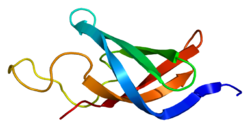Y box binding protein 1 also known as Y-box transcription factor or nuclease-sensitive element-binding protein 1 is a protein that in humans is encoded by the YBX1 gene. [5] YBX1 is an RNA binding protein [6] that stabilises messenger RNAs modified with N6-methyladenosine. [7]





